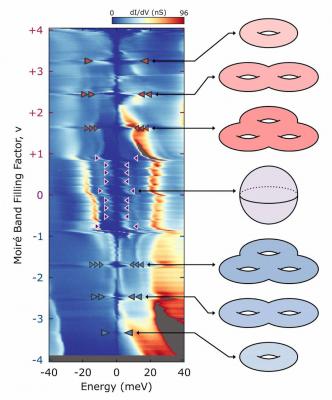Researchers from Princeton, in collaboration with the National Institute for Materials Science in Japan, have discovered that, under certain conditions, interacting electrons in ‘magic angle' graphene can create topological quantum states. This finding may hold potential for revolutionizing electrical engineering, materials science and especially computer science.
 the different insulating states of the magic-angle graphene, each characterized by an integer called its Chern number, which distinguishes between different topological phases. Image from Princeton webstie
the different insulating states of the magic-angle graphene, each characterized by an integer called its Chern number, which distinguishes between different topological phases. Image from Princeton webstie
Topological states of matter are particularly intriguing classes of quantum phenomena. Their study combines quantum physics with topology, which is the branch of theoretical mathematics that studies geometric properties that can be deformed but not intrinsically changed.
But by using 'magic-angle' twisted bilayer graphene, Yazdani and his team were able to explore how interacting electrons can give rise to surprising phases of matter.
About two years ago, Pablo Jarillo-Herrero and his team at the Massachusetts Institute of Technology (MIT) induced superconductivity in graphene â a state in which electrons flow freely without any resistance. The discovery was immediately recognized as a new material platform for exploring unusual quantum phenomena. Yazdani and his fellow researchers were intrigued by this discovery and set out to further explore the intricacies of superconductivity.
But what they discovered led them down a different path. This was a wonderful detour that came out of nowhere, said Kevin Nuckolls, the lead author of the paper and a graduate student in physics. It was totally unexpected, and something we noticed that was going to be important.
Following the example of Jarillo-Herrero and his team, Yazdani, Nuckolls and the other researchers focused their investigation on twisted bilayer graphene. To get the desired quantum effect, the Princeton researchers, following the work of Jarillo-Herrero, placed two sheets of graphene on top of each other with the top layer angled slightly. This twisting creates a moiré pattern, which resembles and is named after a common French textile design. The important point, however, is the angle at which the top layer of graphene is positioned: precisely 1.1 degrees, the magic angle that produces the quantum effect.
It’s such a weird glitch in nature, Nuckolls said, that it is exactly this one angle that needs to be achieved. Angling the top layer of graphene at 1.2 degrees, for example, produces no effect.
The researchers generated extremely low temperatures and created a slight magnetic field. They then used a scanning tunneling microscope, which relies on a technique called quantum tunneling rather than light to view the atomic and subatomic world. They directed the microscope’s conductive metal tip on the surface of the magic-angle twisted graphene and were able to detect the energy levels of the electrons.
They found that the magic-angle graphene changed how electrons moved on the graphene sheet. It creates a condition which forces the electrons to be at the same energy, said Yazdani. We call this a ‘flat band.’
When electrons have the same energy â are in a flat band material â they interact with each other very strongly. This interplay can make electrons do many exotic things, Yazdani said.
One of these exotic things, the researchers discovered, was the creation of unexpected and spontaneous topological states.
This twisting of the graphene creates the right conditions to create a very strong interaction between electrons, Yazdani explained. And this interaction unexpectedly favors electrons to organize themselves into a series of topological quantum states.
Specifically, they discovered that the interaction between electrons creates what are called topological insulators. These are unique devices that act as insulators in their interiors, which means that the electrons inside are not free to move around and therefore do not conduct electricity. However, the electrons on the edges are free to move around, meaning they are conductive. Moreover, because of the special properties of topology, the electrons flowing along the edges are not hampered by any defects or deformations. They flow continuously and effectively circumvent the constraints â such as minute imperfections in a material’s surface â that typically impede the movement of electrons.
Our theory shows that two important ingredients â interactions and topology â which in nature mostly appear decoupled from each other, combine in this system, Andrei Bernevig, professor of physics at Princeton, said. This coupling creates the topological insulator states that were observed experimentally.
Although the field of quantum topology is relatively new, it could transform computer science. People talk a lot about its relevance to quantum computing, where you can use these topological quantum states to make better types of quantum bits, Yazdani said. The motivation for what we’re trying to do is to understand how quantum information can be encoded inside a topological phase. Research in this area is producing exciting new science and can have potential impact in advancing quantum information technologies.
Yazdani and his team will continue their research into understanding how the interactions of electrons give rise to different topological states.
The interplay between the topology and superconductivity in this material system is quite fascinating and is something we will try to understand next, Yazdani said.